Design of Rate-Compatible Parallel Concatenated Punctured Polar Codes for IR-HARQ Transmission Schemes
Abstract
:1. Introduction
- We investigate an improved random puncturing (IRP) pattern for the PCPP coding scheme to obtain a sequence of nested encoding functions in a PCPP coding block transmission, for which the set of parity bits of a higher code-rate polar code is a subset of the set of parity bits of a lower code-rate polar code for a PCPP coding block IR-HARQ transmission. The proposed IRP algorithm only selects puncturing bits from the frozen bits set and keeps the information bits unchanged during puncturing, which can achieve 0.2–1 dB decoding performance improvement more than the existing random puncturing (RP) algorithm.
- To realize multiple blocks transmission over a time-varying channel, we develop an RC IR-HARQ transmission scheme based on PCPP codes, where Refs. [32,33] were only optimized in a single block transmission case. By analyzing the overhead of the previous successful decoded PCPP coding block in our IR-HARQ scheme, the optimal initial code-rate can be determined for each new PCPP coding block over time-varying channels. Simulation results show that the average number of transmissions is about 1.8 times for each PCPP coding block in our RC IR-HARQ scheme with a 2-level PCPP encoding construction, which reduces half of the average number of transmissions than the existing RC polar coding schemes.
2. Preliminaries
2.1. Polar Codes
2.2. Successive-Cancellation (SC) Decoding
2.3. Rate-Compatible Polar Codes
3. Improved Random Puncturing Algorithm Polar Codes
4. System Model
5. Rate-Compatible IR-HARQ Transmission Scheme Based on PCPP Codes
5.1. Initial Code-Rate and Number of Transmissions of the RC IR-HARQ Scheme
5.2. Optimization Method for the 1st PCPP Coding Block of the RC IR-HARQ Transmission Scheme
5.3. Parameter Optimization
6. Simulation and Comparison
6.1. Performance of the Improved Random Puncturing Algorithm
6.2. Performance of the RC IR-HARQ Transmission Scheme
7. Conclusions
Acknowledgments
Author Contributions
Conflicts of Interest
References
- Arikan, E. Channel polarization: A method for constructing capacity-achieving codes for symmetric binary-input memoryless channels. IEEE Trans. Inf. Theory 2009, 55, 3051–3073. [Google Scholar] [CrossRef] [Green Version]
- Mori, R.; Tanaka, T. Performance and construction of polar codes on symmetric binary-input memoryless channels. In Proceedings of the IEEE International Symposium on Information Theory(ISIT), Seoul, Korea, 28 June–3 July 2009. [Google Scholar]
- Vangala, H.; Viterbo, E.; Hong, Y. A comparative study of polar code constructions for the awgn channel. arXiv 2015, arXiv:1501.02473. [Google Scholar]
- Li, H.; Yuan, J. A practical construction method for polar codes in awgn channels. In Proceedings of the IEEE Tencon Spring Conference (TSC), Sydney, Australia, 17–19 April 2013. [Google Scholar]
- Mondelli, M.; Hassani, S.; Maric, I.; Hui, D.; Hong, S. Capacity-achieving rate-compatible polar codes for general channels. In Proceedings of the IEEE Wireless Communications and Networking Conference Workshops (WCNCW), San Francisco, CA, USA, 19–22 March 2017. [Google Scholar]
- Arikan, E. A performance comparison of polar codes and reed-muller codes. IEEE Commun. Lett. 2008, 12, 447–449. [Google Scholar] [CrossRef] [Green Version]
- Mondelli, M.; Urbanke, R.; Hassani, S.H. Unified scaling of polar codes: Error exponent, scaling exponent, moderate deviations, and error floors. In Proceedings of the IEEE International Symposium on Information Theory (ISIT), Hong Kong, China, 14–19 June 2015. [Google Scholar]
- Hussami, N.; Korada, S.B.; Urbanke, R. Performance of polar codes for channel and source coding. In Proceedings of the IEEE International Symposium on Information Theory (ISIT), Seoul, Korea, 28 June–3 July 2009; pp. 1488–1492. [Google Scholar]
- Tal, I.; Vardy, A. List decoding of polar codes. In Proceedings of the IEEE International Symposium on Information Theory (ISIT), St. Petersburg, Russia, 31 July–5 August 2011. [Google Scholar]
- Chen, K.; Niu, K.; Lin, J.R. List successive cancellation decoding of polar codes. Electron. Lett. 2012, 48, 500–501. [Google Scholar] [CrossRef]
- Niu, K.; Chen, K. CRC-aided decoding of polar codes. IEEE Commun. Lett. 2012, 16, 1668–1671. [Google Scholar] [CrossRef]
- Saber, H.; Marsland, I. An incremental redundancy hybrid ARQ scheme via puncturing and extending of polar codes. IEEE Trans. Commun. 2015, 63, 3964–3973. [Google Scholar] [CrossRef]
- Kim, H. Coding and modulation techniques for high spectral efficiency transmission in 5G and satcom. In Proceedings of the 23rd European Signal Processing Conference (EUSIPCO), Nice, France, 31 August–4 September 2015; pp. 2746–2750. [Google Scholar]
- Pandey, M.K.; Gaurav, A.; Kumar, V. Social, technical and economical challenges of 5G technology in indian prospective: Still 4G auction not over, but time to think about 5G in india. In Proceedings of the 2015 International Conference on Computer and Computational Sciences (ICCCS), Noida, India, 7–29 January 2015; pp. 157–162. [Google Scholar]
- Pirinen, P. A brief overview of 5g research activities. In Proceedings of the 1st International Conference on 5G for Ubiquitous Connectivity (5GU), Akaslompolo, Finland, 26–28 November 2014. [Google Scholar]
- Droste, H.; Rost, P.; Doll, M. An adaptive 5G multiservice and multitenant radio access network architecture. Trans. Emerg. Telecommun. Technol. 2016, 27, 1262–1270. [Google Scholar] [CrossRef]
- Posnakides, D.; Mavromoustakis, C.X.; Skourletopoulos, G. Performance analysis of a rate-adaptive bandwidth allocation scheme in 5G mobile networks. In Proceedings of the IEEE Symposium on Computers and Communication (ISCC), Larnaca, Cyprus, 6–9 July 2015. [Google Scholar]
- Simsek, M.; Zhang, D.; Öhmann, D. On the flexibility and autonomy of 5G wireless networks. IEEE Access 2017, 5, 22823–22835. [Google Scholar] [CrossRef]
- Babich, F.; Noschese, M.; Vatta, F. Analysis and design of rate compatible LDPC codes. In Proceedings of the International Symposium on Personal, Indoor, and Mobile Radio Communications (PIMRC), Valencia, Spain, 4–8 September 2016. [Google Scholar]
- Choi, J. On channel-aware secure HARQ-IR. IEEE Trans. Inf. Forens. Secur. 2017, 12, 351–362. [Google Scholar] [CrossRef]
- Khosravirad, S.R.; Pedersen, K.I.; Mudolo, L.; Bakowski, K. HARQ enriched feedback design for 5G technology. In Proceedings of the IEEE 84th Vehicular Technology Conference (VTC-Fall), Montreal, QC, Canada, 18–21 September 2016. [Google Scholar]
- Larsson, P.; Rasmussen, L.K.; Skoglund, M. Throughput analysis of Hybrid-ARQ—A matrix exponential distribution approach. IEEE Trans. Commun. 2016, 64, 416–428. [Google Scholar] [CrossRef]
- Mohammadi, M.; Collings, I.; Zhang, Q. Simple hybrid ARQ schemes based on systematic polar codes for IoT applications. IEEE Commun. Lett. 2017, 21, 975–978. [Google Scholar] [CrossRef]
- Zhang, L.; Zhang, Z.; Wang, X.; Yu, Q. On the puncturing patterns for punctured polar codes. In Proceedings of the IEEE International Symposium on Information Theory (ISIT), Honolulu, HI, USA, 29 June–4 July 2014; pp. 121–125. [Google Scholar]
- Eslami, A.; Pishro-Nik, H. A practical approach to polar codes. In Proceedings of the IEEE International Symposium on Information Theory Proceedings (ISIT), St. Petersburg, Russia, 31 July 2011. [Google Scholar]
- Shin, D.M.; Lim, S.-C.; Yang, K. Design of length-compatible polar codes based on the reduction of polarizing matrices. IEEE Trans. Commun. 2013, 61, 2593–2599. [Google Scholar] [CrossRef]
- Niu, K.; Chen, K.; Lin, J.R. Beyond turbo codes: Rate-compatible punctured polar codes. In Proceedings of the IEEE International Conference on Communications (ICC), Budapest, Hungary, 9–13 June 2013. [Google Scholar]
- Miloslavskaya, V. Shortened polar codes. IEEE Trans. Inf. Theory 2015, 61, 4852–4865. [Google Scholar] [CrossRef]
- Feng, B.; Jiao, J.; Wang, S.; Wu, S.; Zhang, Q. Construction of polar codes concatenated to space-time block coding in MIMO system. In Proceedings of the IEEE 84th Vehicular Technology Conference (VTC-Fall), Montreal, QC, Canada, 18–21 September 2016. [Google Scholar]
- Feng, B.; Zhang, Q.; Jiao, J. An efficient rateless scheme based on the extendibility of systematic polar codes. IEEE Access 2017, 5, 23223–23232. [Google Scholar] [CrossRef]
- Hong, S.-N.; Hui, D.; Marić, I. On the catastrophic puncturing patterns for finite-length polar codes. In Proceedings of the 50th Asilomar Conference on Signals, Systems and Computers (ACSSC), Pacific Grove, CA, USA, 6–9 November 2016. [Google Scholar]
- Li, B.; Tse, D.; Chen, K.; Shen, H. Capacity-achieving rateless polar codes. In Proceedings of the IEEE International Symposium on Information Theory (ISIT), Barcelona, Spain, 10–15 July 2016. [Google Scholar]
- Hong, S.-N.; Hui, D.; Mari, I. Capacity-achieving rate-compatible polar codes. In Proceedings of the IEEE International Symposium on Information Theory (ISIT), Barcelona, Spain, 10–15 July 2016. [Google Scholar]
- Niu, K.; Chen, K.; Lin, J.; Zhang, Q.T. Polar codes: Primary concepts and practical decoding algorithms. Commun. Mag. IEEE 2014, 52, 192–203. [Google Scholar] [CrossRef]
- Alamdar-Yazdi, A.; Kschischang, F.R. A simplified successive-cancellation decoder for polar codes. IEEE Commun. Lett. 2011, 15, 1378–1380. [Google Scholar] [CrossRef]
- Niu, K.; Chen, K. Stack decoding of polar codes. Electron. Lett. 2012, 48, 695–697. [Google Scholar] [CrossRef]
- Hassani, S.H.; Urbanke, R. Universal polar codes. In Proceedings of the IEEE International Symposium on Information Theory, Honolulu, HI, USA, 29 June–4 July 2014. [Google Scholar]
- Performance of Rate Matching Schemes for Polar Codes. R1-1712647, Prague, Czech Republic, 21–25 August 2017. Available online: http://portal.3gpp.org/ngppapp/TdocList.aspx (accessed on 28 August 2017).
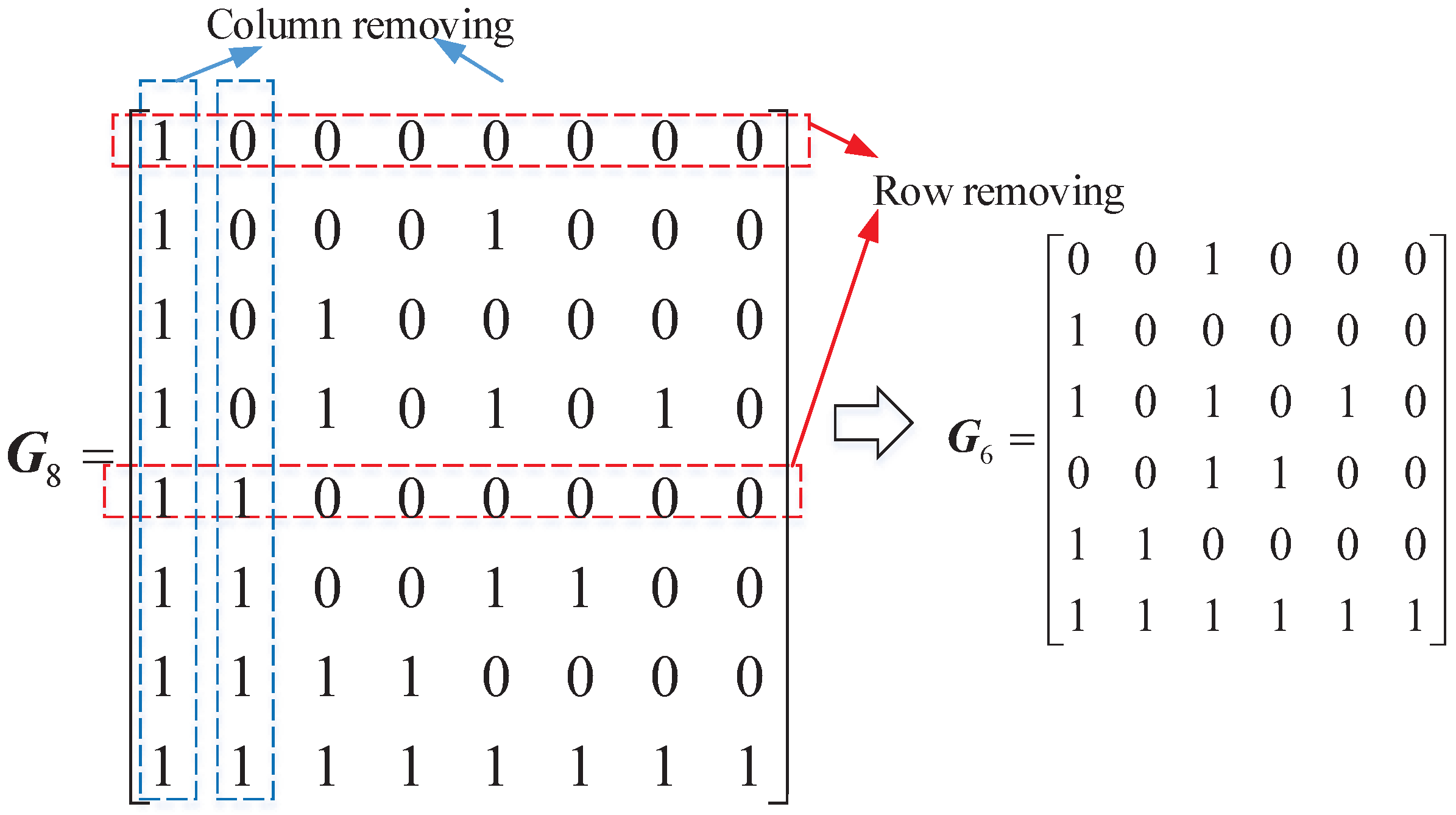
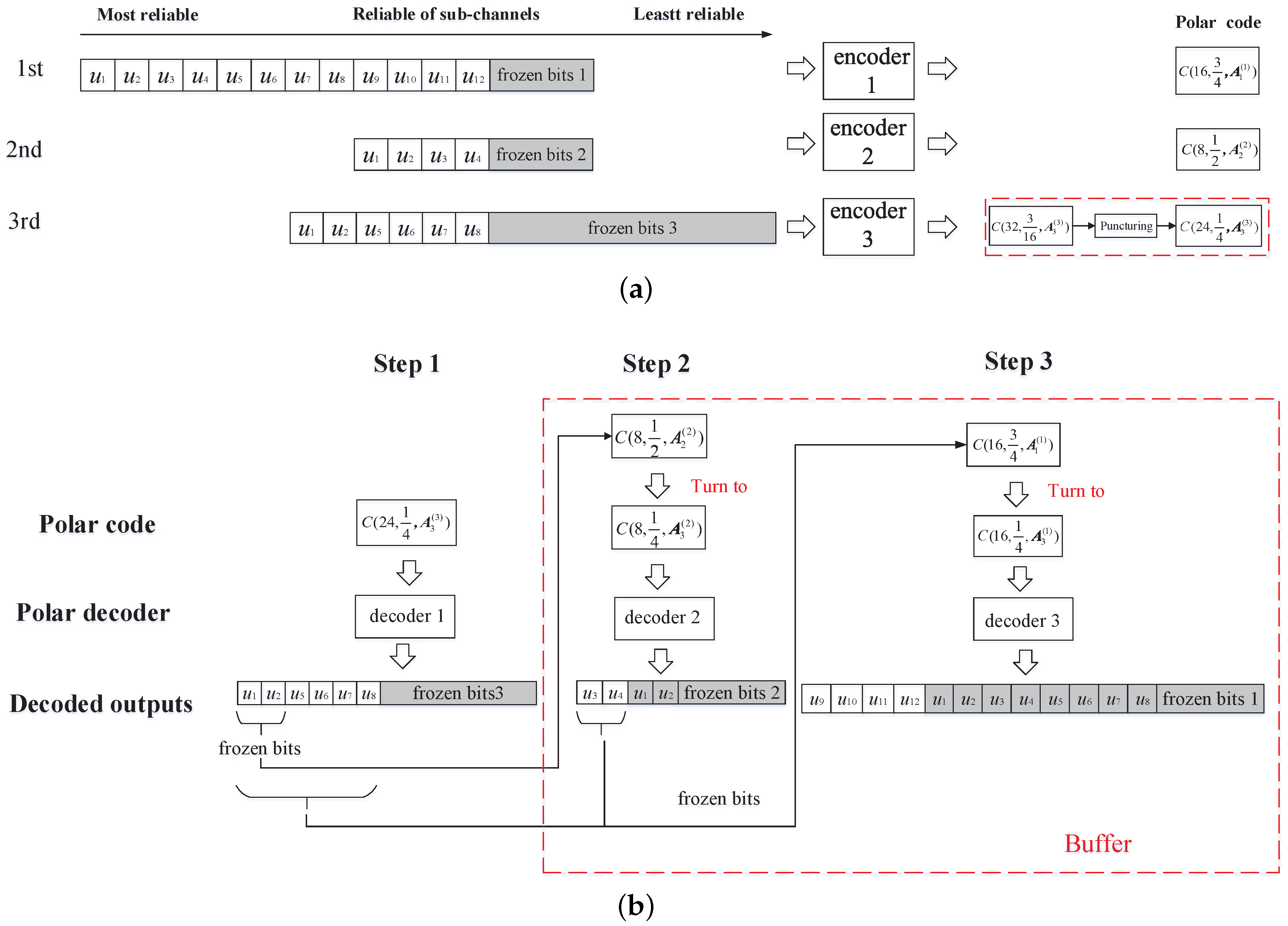
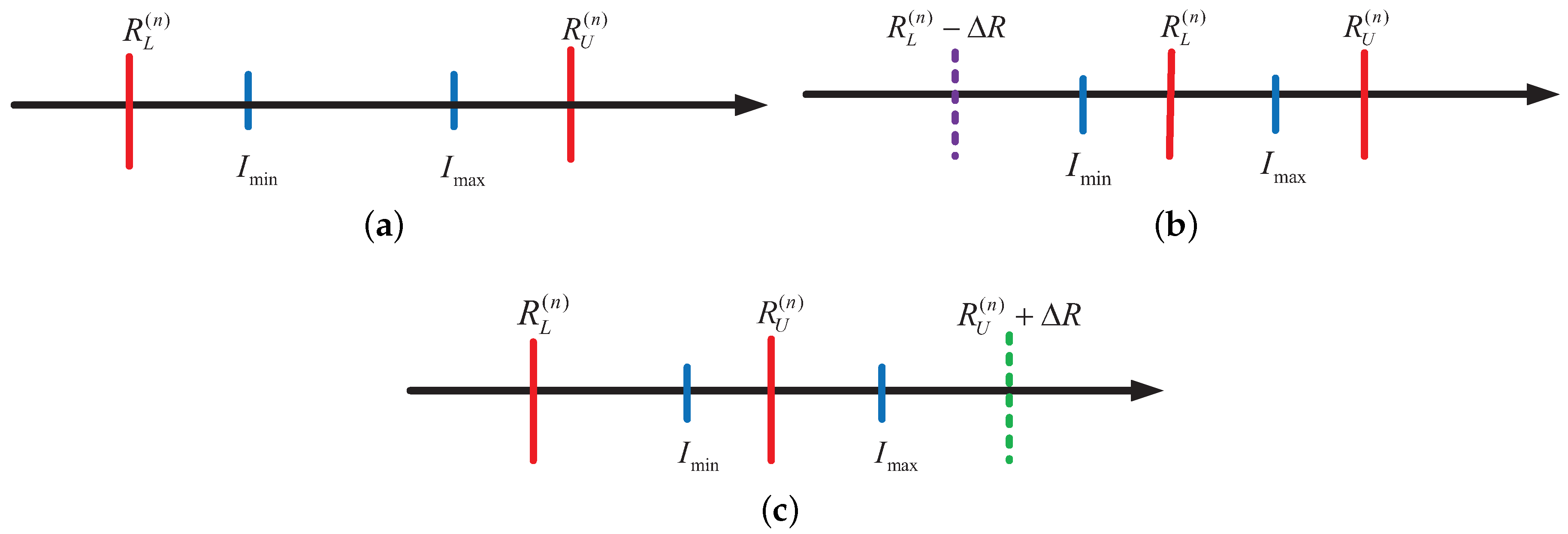
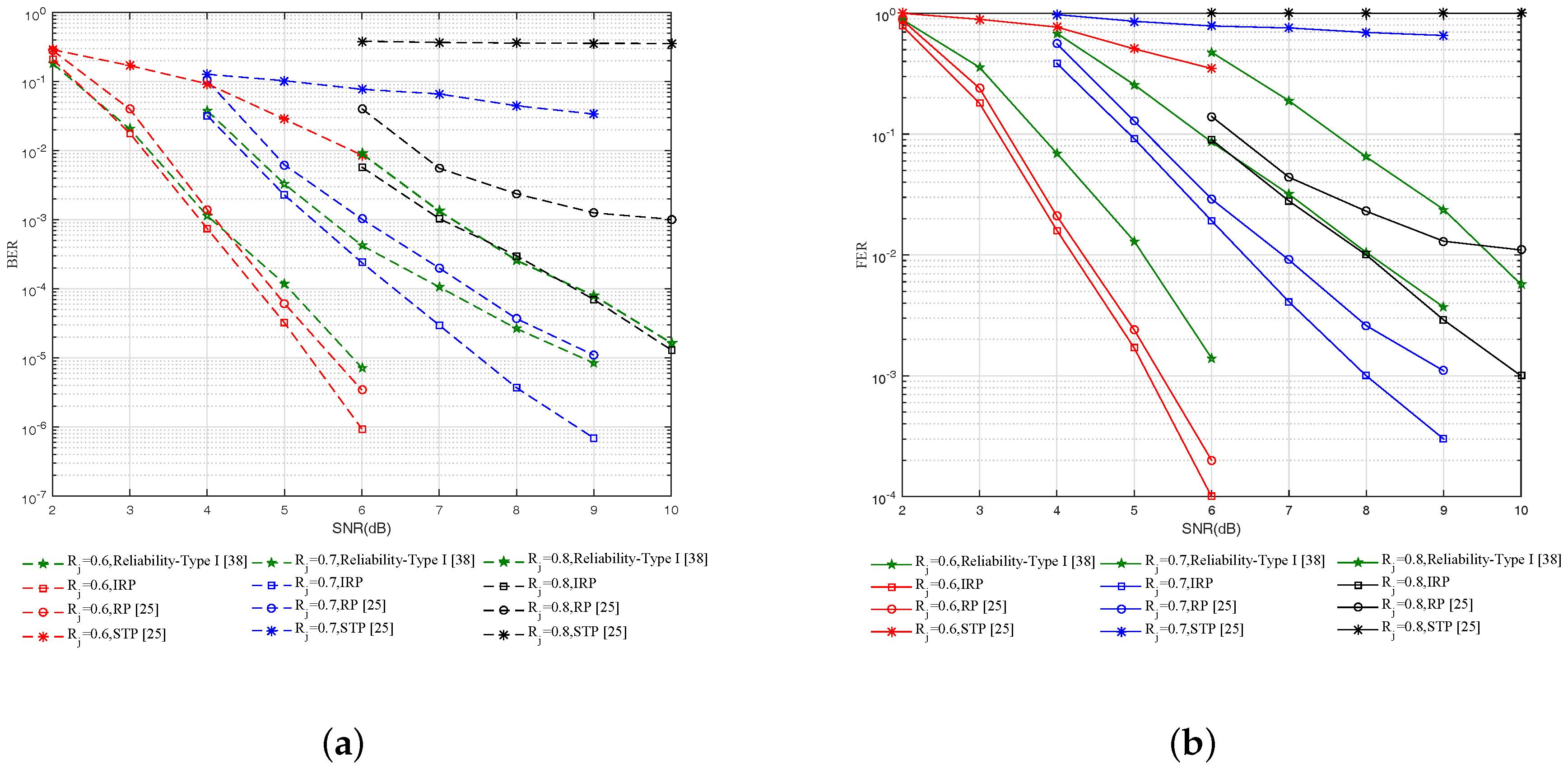
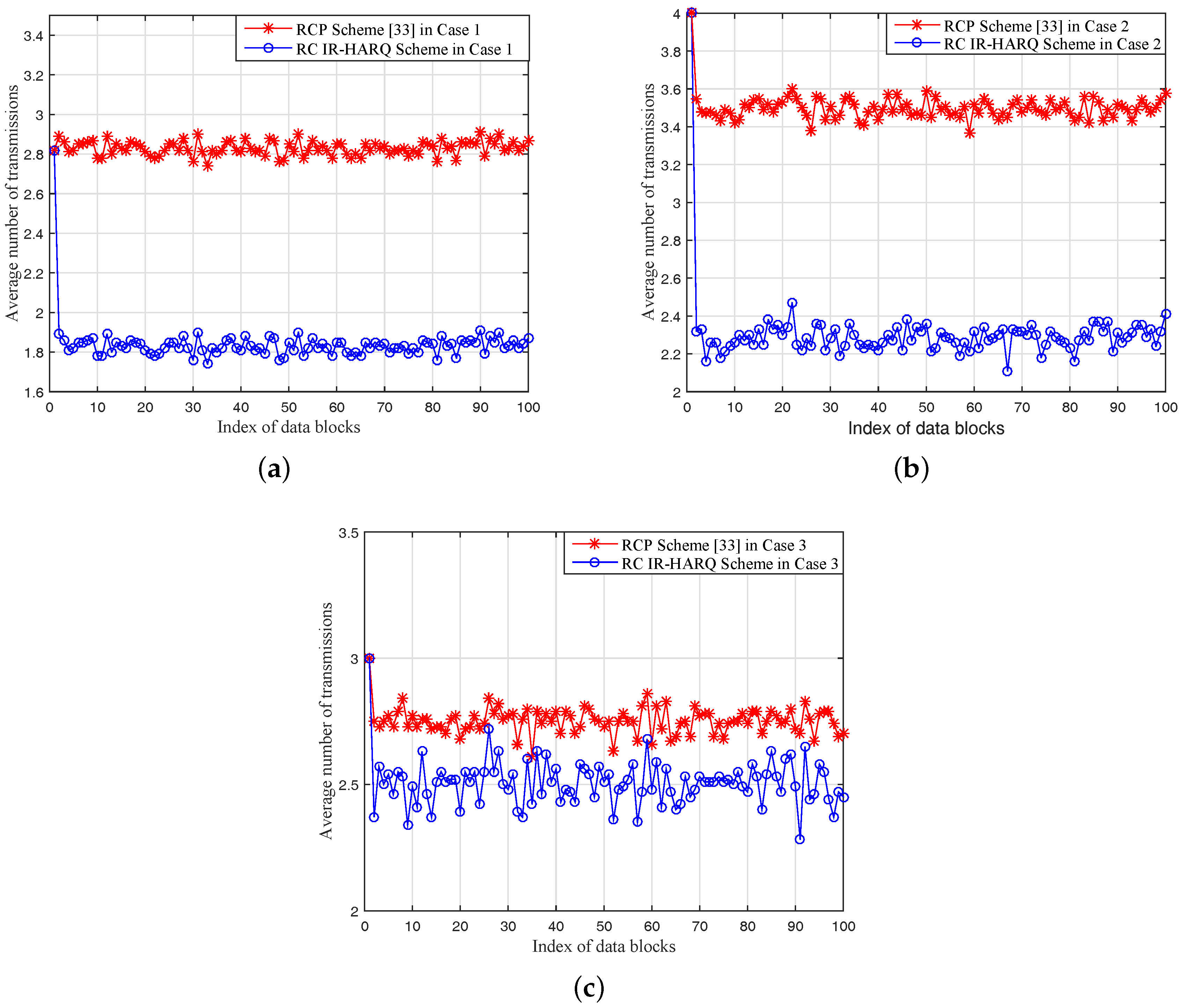
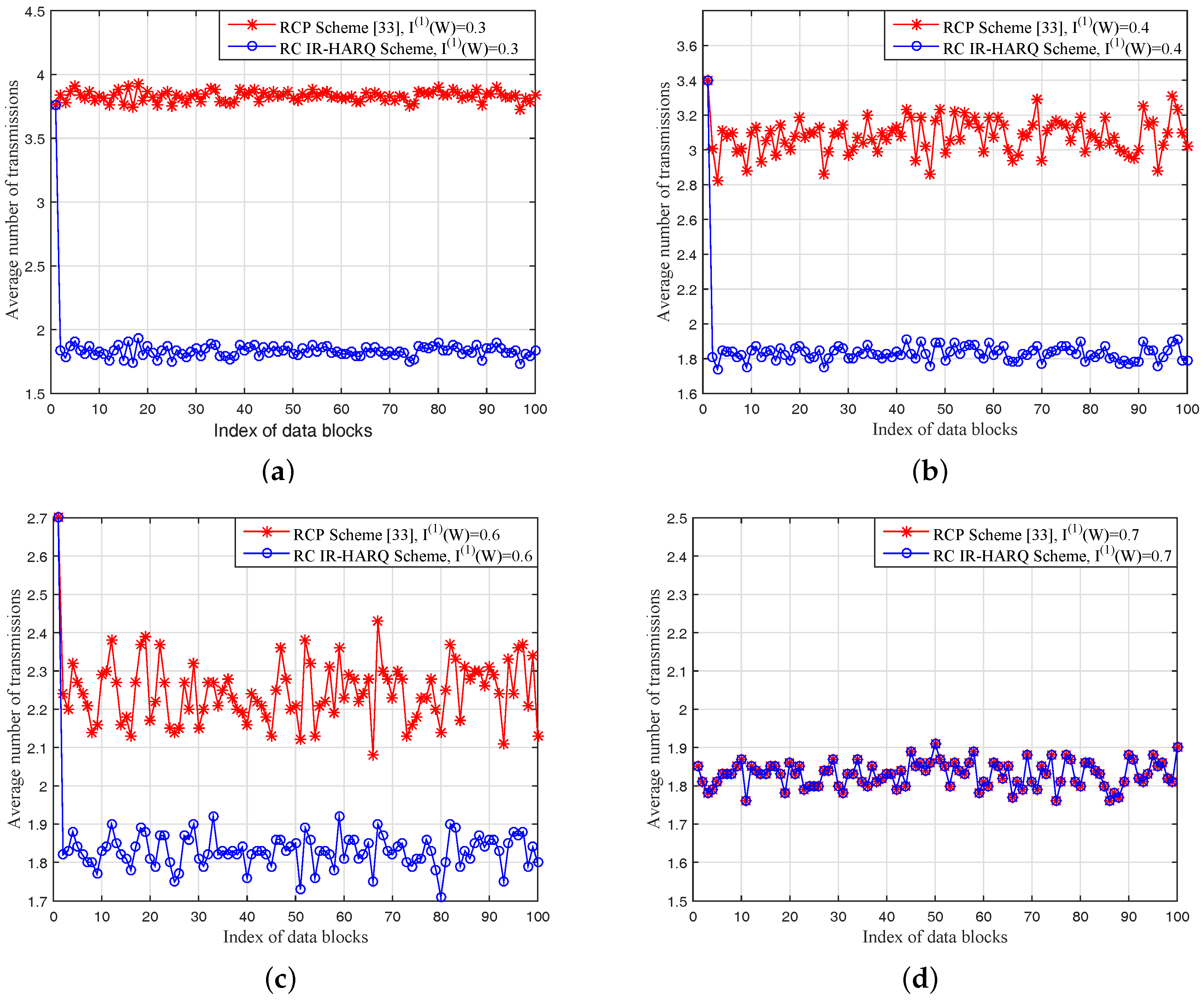
| Initial Code-Rate | Channel Capacity | Result |
|---|---|---|
| increase | transmissions at most | |
| decrease | transmissions at least | |
| increase | 1 transmission | |
| decrease | 2 transmissions at least |
| Initial Code-Rate | Channel Capacity | Value Range of | Transmission Rounds | Coding Pairs |
|---|---|---|---|---|
| Case 1: | increase | 1 | 1 | |
| 2 | 2 | |||
| decrease | 2 | 2 | ||
| Case 2: | increase | 1 | 1 | |
| 2 | 2 | |||
| decrease | 2 | 2 | ||
| 3 | 3 | |||
| Case 3: | increase | 1 | 1 | |
| 2 | 1 | |||
| 3 | 2 | |||
| decrease | 2 | 2 | ||
| 3 | 2 |
| Parameters | Value |
|---|---|
| Block length of mother polar codes | 1024 |
| Mother polar code-rate | 0.5 |
| Punctured polar code-rates | 0.6, 0.7, 0.8 |
| Polar codes decoder | SCL |
| Modulation | BPSK |
| Parameters | Value |
|---|---|
| The initial code-rate of the first data block | 0.8 |
| Variation range of the channel capacity | |
| The number of data blocks | 100 |
| The simulation times for each data block | 100 |
| Initial channel capacity in Figure 5 | 0.5 |
| Rate difference of the 3 cases in Figure 5 | Case 1: Case 2: Case 3: |
| Initial channel capacity in Figure 6 | 0.3, 0.4, 0.6, 0.7 |
| Rate difference of the Case 1 in Figure 6 | Case 1: |
© 2017 by the authors. Licensee MDPI, Basel, Switzerland. This article is an open access article distributed under the terms and conditions of the Creative Commons Attribution (CC BY) license (http://creativecommons.org/licenses/by/4.0/).
Share and Cite
Jiao, J.; Wang, S.; Feng, B.; Gu, S.; Wu, S.; Zhang, Q. Design of Rate-Compatible Parallel Concatenated Punctured Polar Codes for IR-HARQ Transmission Schemes. Entropy 2017, 19, 628. https://doi.org/10.3390/e19110628
Jiao J, Wang S, Feng B, Gu S, Wu S, Zhang Q. Design of Rate-Compatible Parallel Concatenated Punctured Polar Codes for IR-HARQ Transmission Schemes. Entropy. 2017; 19(11):628. https://doi.org/10.3390/e19110628
Chicago/Turabian StyleJiao, Jian, Sha Wang, Bowen Feng, Shushi Gu, Shaohua Wu, and Qinyu Zhang. 2017. "Design of Rate-Compatible Parallel Concatenated Punctured Polar Codes for IR-HARQ Transmission Schemes" Entropy 19, no. 11: 628. https://doi.org/10.3390/e19110628





